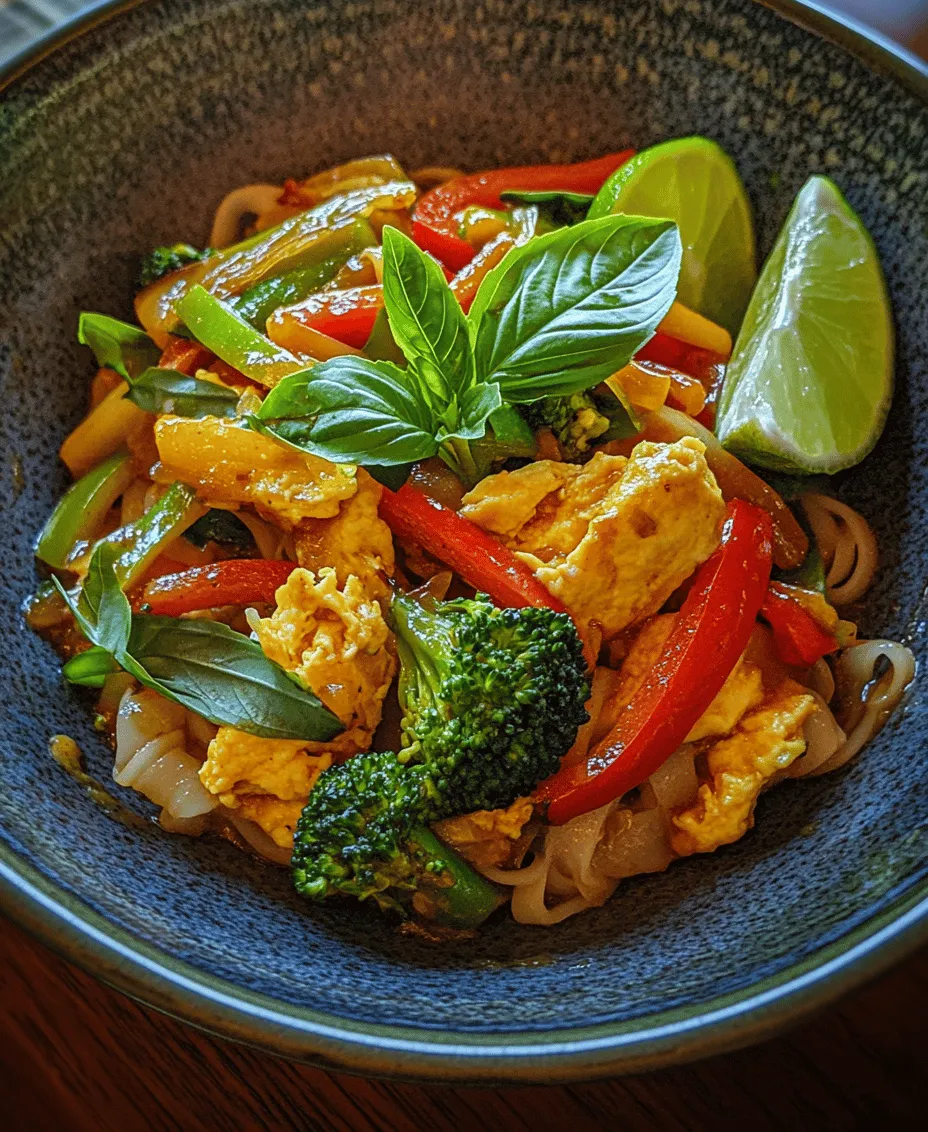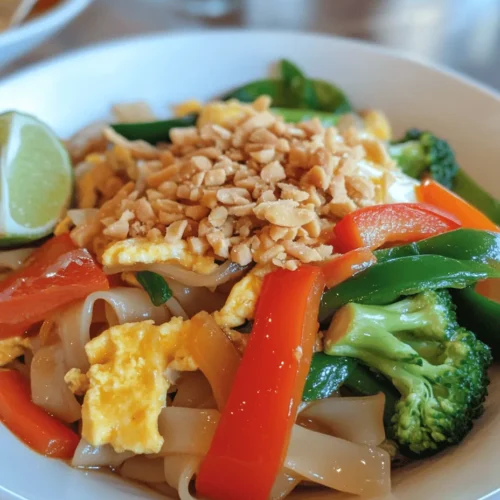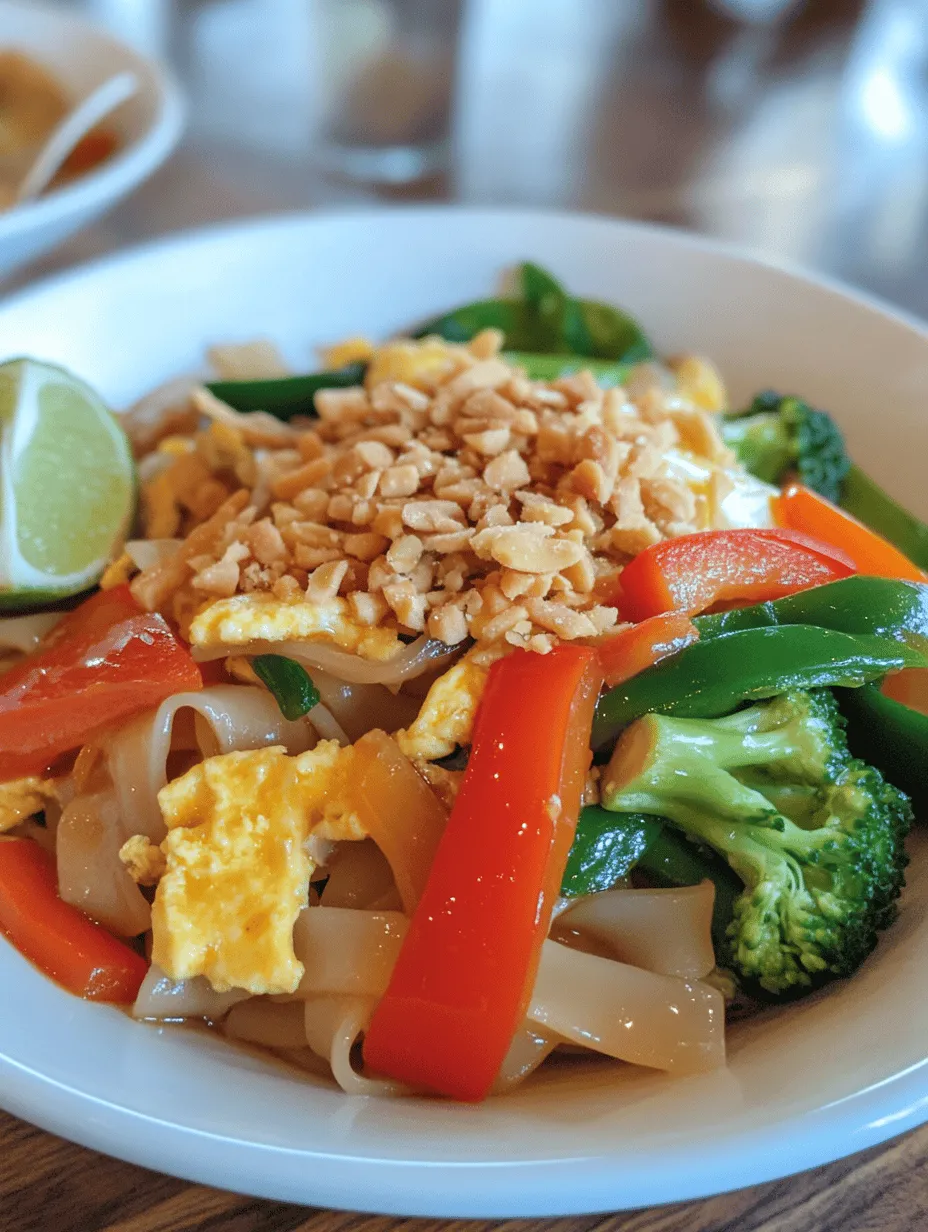Introduction
If you’re looking to spice up your weeknight dinners, Drunken Noodles, also known as Pad Kee Mao, is a vibrant and flavorful dish that brings the heart of Thai cuisine straight to your kitchen. This beloved stir-fried noodle dish is characterized by its bold flavors and aromatic ingredients, making it a favorite among food enthusiasts and casual cooks alike. The name “Drunken Noodles” is said to refer to the dish’s ability to revive anyone who’s had a little too much to drink, but it also reflects the lively, intoxicating flavors that dance across your palate with every bite.
Drunken Noodles feature a delightful medley of flat rice noodles, fresh vegetables, and an array of sauces that come together to create an irresistible dish. What makes this recipe particularly appealing is its accessibility; whether you’re a novice in the kitchen or a seasoned chef, Drunken Noodles can be prepared in a matter of minutes. The simplicity of the cooking process, paired with the complexity of flavors, makes it a perfect choice for busy weeknights or casual gatherings.
In this article, we’ll explore the background of Drunken Noodles, delve into its rich history, and provide a detailed breakdown of the ingredients that make this dish a true masterpiece. Get ready to embark on a culinary adventure that will leave your taste buds tingling.
Understanding Drunken Noodles
The Origin and History of Drunken Noodles
Drunken Noodles, or Pad Kee Mao, has its roots deeply embedded in Thai street food culture. The dish is believed to have originated in Thailand, where it was often served at late-night eateries frequented by revelers looking for a satisfying meal after a night out. The exact origins of the name remain somewhat of a mystery, but many attribute it to the dish’s popularity as a remedy for hangovers.
Traditionally, Drunken Noodles are made with wide rice noodles, which are stir-fried with a variety of proteins and vegetables, all tossed in a fragrant sauce. The dish is known for its signature spicy kick, usually derived from fresh chili peppers or chili flakes, which can be adjusted based on personal preference. In addition to offering a delicious meal, Drunken Noodles also reflect the communal dining culture of Thailand, where food is often shared among friends and family.
Traditional Ingredients and Their Roles
One of the most intriguing aspects of Drunken Noodles is the balance of flavors and textures created by its diverse ingredients. The traditional components of this dish include:
– Flat Rice Noodles: The backbone of Drunken Noodles, these chewy noodles soak up the flavors of the sauces and spices, providing a hearty base.
– Proteins: Commonly used proteins include chicken, beef, shrimp, or tofu, adding richness and depth to the dish.
– Vegetables: Fresh vegetables like bell peppers, broccoli, and onions not only enhance the dish’s visual appeal but also add essential nutrients.
– Aromatics: Garlic and onion are crucial for building the foundational flavors, imparting warmth and depth to the dish.
– Sauces: A combination of soy sauce, oyster sauce, fish sauce, and dark soy sauce creates a harmonious blend of salty, sweet, and umami flavors.
– Herbs and Spices: Thai basil leaves provide a unique and fragrant note, while chili flakes allow for customization of spice levels.
Through the use of these ingredients, Drunken Noodles represents the vibrant and diverse culinary heritage of Thailand, showcasing the importance of fresh, high-quality produce and well-balanced seasonings.
Variations Across Regions and Cultures
While the classic version of Drunken Noodles remains a staple in Thai cuisine, variations of the dish can be found throughout Southeast Asia. Each region boasts its own unique spin, influenced by local ingredients and culinary traditions.
In Thailand, you might find Drunken Noodles prepared with a variety of leafy greens, such as bok choy or kale, and a range of proteins that reflect the area’s agricultural bounty. Some versions may incorporate additional spices or sauces, creating a more complex flavor profile.
In neighboring countries, the essence of Drunken Noodles is often preserved while introducing local twists. For example, in Laos, a similar dish known as “khao poon” features rice noodles served in a spicy broth, a testament to the adaptability of noodle dishes across cultures.
As you explore Drunken Noodles Delight, you’ll not only experience the rich flavors of Thailand but also gain insight into the broader culinary landscape of Southeast Asia.
Ingredients Breakdown
To create the perfect Drunken Noodles Delight, it’s essential to understand the role of each ingredient. Below is a detailed analysis of the components that come together to create this delicious dish.
Flat Rice Noodles
Flat rice noodles, also known as “sen yai,” are the star of Drunken Noodles. These wide noodles are typically made from rice flour and water, giving them a soft and chewy texture when cooked. When selecting your noodles, look for fresh or dried varieties. If using dried noodles, soak them in warm water until they soften before stir-frying. The key to achieving the best texture is to ensure they are cooked al dente, allowing them to absorb the flavors of the sauces without becoming mushy.
Vegetable Oil
Choosing the right oil for stir-frying is crucial. A high smoke point oil, such as vegetable or peanut oil, is ideal for this dish. These oils can withstand high temperatures without burning, ensuring that your noodles and vegetables achieve that signature stir-fried flavor. If you prefer a more aromatic option, consider using sesame oil for a nutty essence, but use it sparingly as it has a strong flavor.
Minced Garlic and Onion
Garlic and onion form the flavor foundation of Drunken Noodles. Minced garlic adds a pungent aroma and depth of flavor, while onion provides sweetness that balances the dish’s spiciness. Sauté these aromatics in hot oil before adding the noodles and other ingredients to build a rich flavor base.
Bell Peppers
Bell peppers not only add vibrant color to your plate but also provide a crisp texture and a hint of sweetness. They are a nutritious addition, rich in vitamins A and C. When preparing Drunken Noodles, you can choose a mix of colors—red, yellow, and green—to create a visually stunning dish. Slice them into thin strips for even cooking and maximum flavor infusion.
Broccoli Florets
Broccoli florets contribute both crunch and health benefits to your Drunken Noodles. Packed with vitamins K and C, fiber, and antioxidants, this green vegetable enhances the nutritional value of your meal. To maintain their vibrant color and crisp texture, blanch the broccoli briefly before adding it to the stir-fry. This quick cooking method helps retain its nutrients while allowing it to absorb the flavors of the sauces.
Thai Basil Leaves
Thai basil is an essential herb in Drunken Noodles, imparting a unique flavor profile that distinguishes it from other basil varieties. Its slightly spicy and sweet notes elevate the dish, making it a key ingredient. If you can’t find Thai basil, you can substitute it with regular basil or mint, but be aware that this may alter the final flavor. Add the basil leaves towards the end of cooking to preserve their aromatic qualities.
Eggs
Incorporating eggs into Drunken Noodles adds a rich source of protein and enhances the overall texture of the dish. The eggs can be scrambled in the pan before adding the noodles or tossed in raw, allowing them to cook through as the dish finishes. This step not only increases the protein content but also creates a delightful creamy texture that complements the other ingredients.
Sauces: Soy, Oyster, Fish, and Dark Soy
The magic of Drunken Noodles lies in the balance of flavors achieved through various sauces. Here’s a breakdown of the key sauces used:
– Soy Sauce: Provides a salty base and deep umami flavor to the dish. Use regular soy sauce for a classic taste or low-sodium soy sauce to control saltiness.
– Oyster Sauce: Adds a sweet and savory depth, enhancing the overall flavor profile of the stir-fry. Its glossy finish also contributes to the dish’s visual appeal.
– Fish Sauce: A staple in Thai cuisine, fish sauce lends a pungent, umami flavor. Use sparingly, as it can quickly overpower other flavors.
– Dark Soy Sauce: This thicker sauce adds color and a hint of sweetness. It’s perfect for achieving that characteristic dark hue in your Drunken Noodles.
Balancing these sauces is key to achieving the desired flavor profile. Adjust the quantities based on your taste preferences, and don’t be afraid to experiment with different combinations.
Chili Flakes
For those who enjoy a spicy kick, chili flakes are an essential ingredient in Drunken Noodles. The level of spice can easily be adjusted by varying the amount you add, making it suitable for a wide range of palates. If you prefer less heat, start with a small pinch and gradually increase until you reach your desired spice level.
Lime Wedges
Finally, lime wedges serve as the finishing touch for Drunken Noodles, offering a burst of freshness and acidity that balances the richness of the dish. Squeezing fresh lime juice over the noodles just before serving brightens the flavors and enhances the overall taste experience. A dash of lime elevates the dish, making it even more refreshing and enjoyable.
—
In the next part of this article, we will provide you with step-by-step instructions to prepare Drunken Noodles Delight, along with tips for achieving the best results. Get ready to bring the vibrant flavors of Thailand into your kitchen and impress your friends and family with this delightful dish!

Preparation Steps Explained
Preparing the Noodles: Importance of Timing and Technique
To achieve the perfect Drunken Noodles, the preparation of the noodles is crucial. Begin by selecting high-quality flat rice noodles, which are essential for this dish. Soak the noodles in warm water for about 30-45 minutes before cooking. This soaking time is vital as it allows the noodles to soften without becoming too mushy. Once softened, drain the noodles and set them aside. Timing is key here; you want to ensure that your noodles are ready just before you start stir-frying, ensuring they maintain their texture when combined with the other ingredients.
Tips on Achieving the Perfect Al Dente Texture
For the perfect al dente texture, cook the noodles for a shorter duration than indicated on the package instructions. After soaking, if you choose to briefly boil the noodles, cook them for only 1-2 minutes, tasting frequently. They should have a slight bite to them as they will continue to cook when added to the hot wok during stir-frying. Additionally, rinse the noodles under cold water to halt the cooking process once they reach the desired texture. This method is essential for preventing clumping and ensuring your Drunken Noodles have that delightful chewiness.
Making the Sauce: Combining Flavors for Depth
The sauce is the heart of Drunken Noodles, and creating a well-balanced mixture is vital for depth of flavor. In a bowl, combine soy sauce, oyster sauce, fish sauce, and a touch of sugar. The balance of salty, sweet, and spicy elements is key to achieving that complex flavor profile characteristic of this dish. To enhance the sauce’s depth, consider adding a splash of rice vinegar. This addition will help cut through the richness of the sauces and provide a touch of acidity, elevating the overall taste. Adjust the ingredients based on your preference for saltiness or sweetness, ensuring the final flavor is uniquely yours.
Importance of Balancing Salty, Sweet, and Spicy Elements
The beauty of Drunken Noodles lies in its ability to balance contrasting flavors. While soy and fish sauces contribute a salty umami flavor, the sugar will add a hint of sweetness, balancing the saltiness. For spiciness, fresh Thai chilies or chili paste can be added according to your heat tolerance. Start with a small amount and taste as you go, as it’s always easier to add more heat than to reduce it. This balance not only enhances the noodles but also brings out the fresh vegetables and proteins included in the dish.
Cooking the Vegetables: Techniques for Perfect Stir-Fry
When it comes to stir-frying, the right technique can make a significant difference in the final outcome of your Drunken Noodles. Start by heating a wok over high heat until it is smoking. This high temperature ensures a quick cook, which helps retain the vibrant colors and crispness of your vegetables. Use a combination of bell peppers, carrots, and broccoli for a mix of flavors and textures.
Add the vegetables in batches, starting with those that take longer to cook, such as carrots, followed by bell peppers, and finishing with leafy greens like bok choy. Stir-fry each vegetable for about 2-3 minutes, keeping them crisp. The goal is to cook them just enough to soften slightly while retaining their crunch and color—this is what gives Drunken Noodles their appealing texture.
Ideal Temperatures and Timing for Maintaining Color and Crunch
Maintaining the right temperature during cooking is essential. A hot wok will sear the vegetables, locking in their colors and flavors. If your wok isn’t hot enough, the vegetables will steam instead of stir-fry, leading to a mushy texture. Remember to keep the ingredients moving in the wok; this not only prevents burning but also ensures even cooking. Aim for a total stir-fry time of about 5-7 minutes for the vegetables, and avoid overcrowding the pan to achieve that perfect crunch.
Incorporating the Eggs: Tips for Scrambling in a Stir-Fry Context
Eggs are a classic addition to Drunken Noodles, adding richness and protein. To incorporate eggs into your stir-fry, push the cooked vegetables to one side of the wok and crack the eggs directly into the empty space. Scramble the eggs gently, letting them cook for about 1-2 minutes until just set. Once scrambled, mix the eggs back with the vegetables, ensuring they are evenly distributed throughout the dish. This technique not only integrates the eggs beautifully but also allows them to absorb the flavors of the sauce and vegetables.
Combining Ingredients: Techniques for Even Distribution of Flavors
Once your vegetables and eggs are cooked, it’s time to combine everything with the noodles and sauce. Add the drained noodles to the wok, followed by your prepared sauce. Using tongs or a spatula, gently toss the ingredients together to ensure even distribution of flavors without breaking the noodles. This step is crucial; if done too aggressively, you may end up with a mushy mess rather than the delightful strands of noodles you desire. Stir-fry everything together for an additional 2-3 minutes, allowing the noodles to absorb the sauce and heat through.
Importance of Temperature and Timing in Stir-Frying
Throughout the stir-frying process, maintaining high heat is essential for achieving the dish’s signature texture and flavor. After adding the noodles, keep the heat high to allow the sauce to caramelize slightly, creating a beautiful glaze that coats every ingredient. Stir-fry for just a few minutes—overcooking at this point can lead to soggy noodles. The goal is to have everything heated through while still retaining the individual character of each component.
Serving Suggestions
Ideal Serving Size and Presentation Tips
Drunken Noodles are best served immediately after cooking to enjoy their optimal texture and flavor. A typical serving size is about 1 ½ to 2 cups per person, depending on individual appetites. For an appealing presentation, consider serving the noodles in a wide, shallow bowl, allowing the vibrant colors of the vegetables and noodles to shine through. Garnish with fresh basil leaves and a wedge of lime on the side for an extra burst of freshness that will entice your guests.
Pairing Options: Complementary Dishes and Beverages
To complement the bold flavors of Drunken Noodles, consider serving them alongside light and refreshing dishes. A simple cucumber salad with a tangy dressing can provide a cool contrast to the heat of the noodles. Additionally, Thai spring rolls or a side of Tom Yum soup can enhance the meal experience. For beverages, iced Thai tea or a light beer pairs wonderfully, balancing the dish’s flavors without overwhelming them.
Alternative Garnishes and Variations to Enhance Presentation
Garnishing is an excellent way to elevate the dish. In addition to basil and lime, you can sprinkle some crushed peanuts on top for added crunch and flavor. Thinly sliced green onions or cilantro can also add a pop of color and freshness. For those who enjoy an extra kick, a drizzle of sriracha or chili oil can be a delightful touch. Variations on the dish can include different proteins such as shrimp, tofu, or chicken, which can be added during the stir-fry process based on personal preference.
Nutritional Information
Breakdown of Nutritional Values Per Serving
A typical serving of Drunken Noodles (without added proteins) contains approximately:
– Calories: 400-500
– Protein: 10-15 grams
– Carbohydrates: 60-70 grams
– Fats: 10-15 grams
– Fiber: 2-3 grams
These values can vary depending on the specific ingredients and portion sizes used.
Discussion of Dietary Considerations (e.g., Vegetarian Adaptations)
Drunken Noodles can easily be adapted to fit various dietary preferences. For a vegetarian version, simply replace the oyster sauce with a vegetarian substitute or use additional soy sauce. Tofu serves as an excellent protein source, providing a delicious texture and flavor that complements the dish. For vegans, ensure that all sauces used are free from animal products.
Health Benefits of Key Ingredients
The key ingredients in Drunken Noodles offer several health benefits. Rice noodles provide a gluten-free option for those with dietary restrictions. Fresh vegetables like bell peppers and broccoli are packed with vitamins and antioxidants, contributing to overall health. Additionally, the use of fresh herbs such as basil not only enhances flavor but also adds nutritional value, including anti-inflammatory properties.
Conclusion
In summary, Drunken Noodles Delight is a vibrant and versatile dish that showcases the rich flavors of Thai cuisine. With its unique combination of salty, sweet, and spicy elements, this recipe is sure to please a variety of palates. The techniques emphasized in the preparation of the noodles, sauce, and vegetables ensure a flavorful and satisfying meal that you can easily recreate at home.
We encourage you to try making Drunken Noodles for your next culinary adventure. The joy of creating and sharing this delightful dish with family and friends will undoubtedly enhance your dining experience. Embrace the flavors of Thailand and let your kitchen come alive with the scents and tastes of this beloved recipe.



